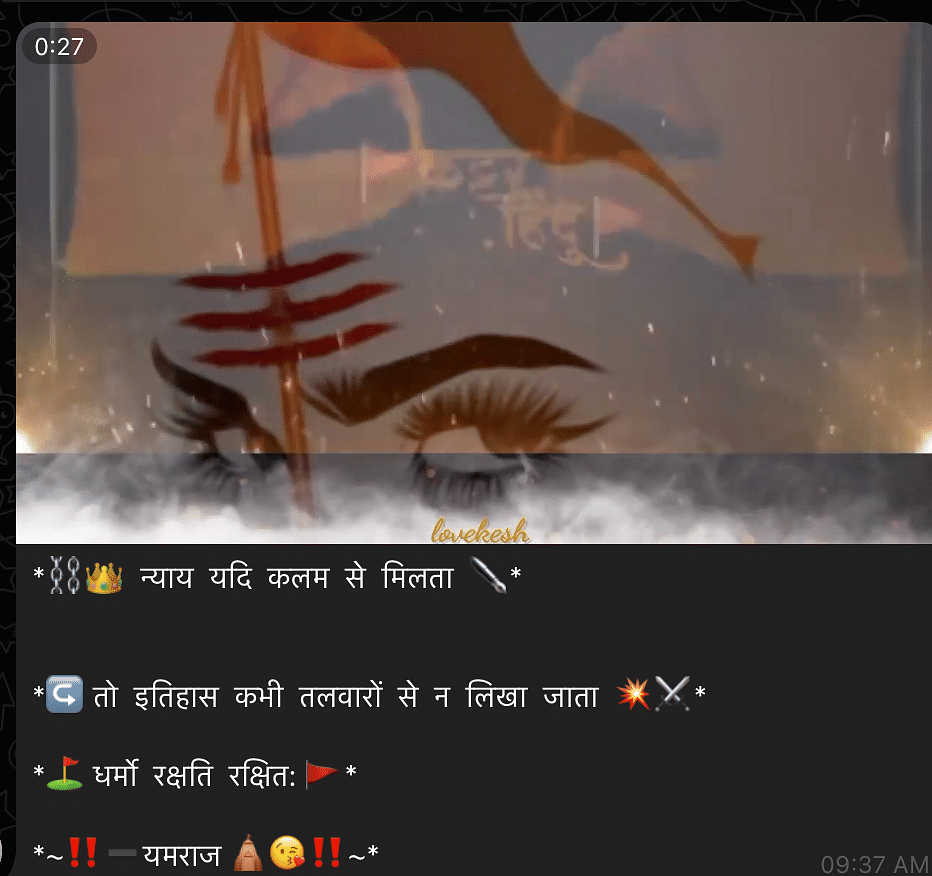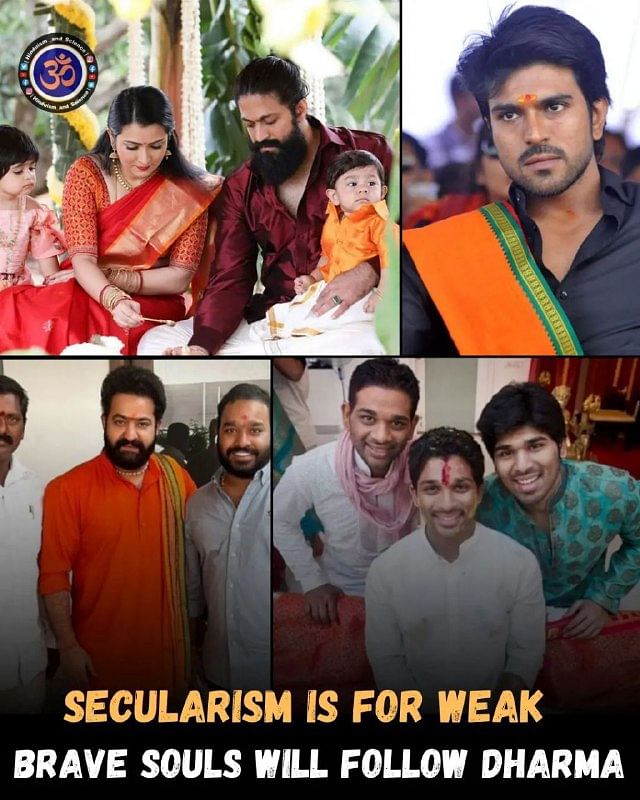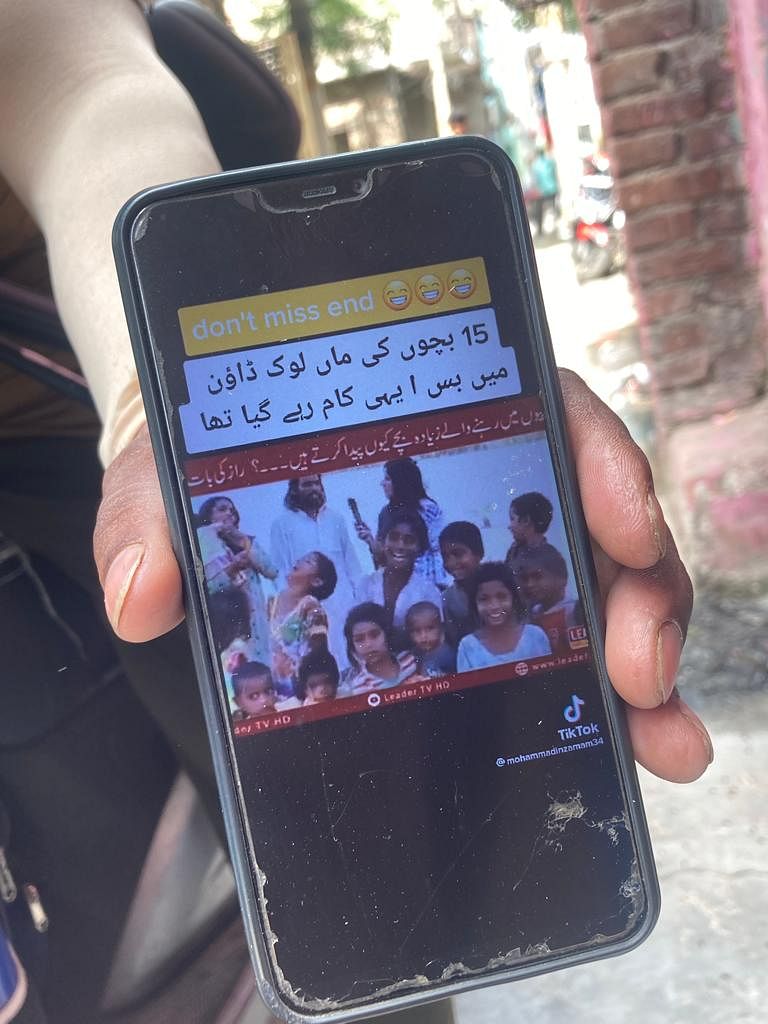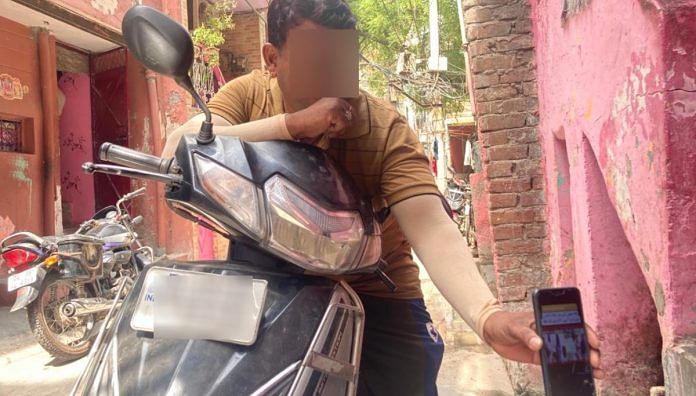Fourteen-year-old Sagar* says he had fun during the rally that turned violent in Delhi’s Jahangirpuri on 16 April. It was exciting, he says.
“I generally like watching dangas (riots) on TV. But now that it’s happened here…,” he trailed off, pulling at the edge of a long-sleeved shirt in the summer heat. He says his arm got hurt recently. “It’s not fun because the shops and all are closed now, and there are so many policemen around.”
The young Hindu residents of Jahangirpuri watch visitors—mostly journalists and police—with interest. It’s been a few days after the communal clash, and they’re careful not to announce their participation. But nearly everyone has the same response to what happened on 16 April: Yes, the Hanuman Jayanti rally turned violent, but why shouldn’t it? After all, they only used force after ‘the other side’ attacked them.
Sagar is one of the several young people who participated in the rally in northwestern Delhi. The rally that turned violent was the third one of the day, and was seen to have included young boys and teenagers. Mobile phone footage shows participants armed with swords and knives chanting “Jai Sri Ram” and dancing to music.
The glorification of violence isn’t new to today’s youth, but there’s a spate of content online that goes one step ahead and encourages it. Social media is replete with WhatsApp forwards with impassioned pleas to protect Hindus, images of angry Gods with six-pack abs, and misinformation and fake news — while television channels and films peddle a new brand of militant nationalism. Even if one isn’t seeking out pro-Hindutva or anti-Muslim content online, social media’s algorithmic bias is almost certain to trap one in an echo chamber.
“I like watching YouTube videos,” Sagar told ThePrint. “Like videos with amazing facts on India, what all happened in the past, and what we need to do to save ourselves today.” He smiles as he confirms that he means he watches videos on “saving Hindus,” and that the videos he watches recommend keeping swords like the ones he saw at the rally.
Does he expect to ever have to carry a sword to save Hindus? “We’ll do it one day,” he replied. “Why not?”

Also read: BJP’s divide-and-rule plan is working – Hate is now fully automated, led by youth
Violence hiding behind culture
Sagar’s favourite YouTube videos are ones about “the Indian civilisation.” He’s also a self-declared Hanuman bhakt, and listens to ‘saffron pop’ — the genre of music with themes of Hindutva and nationalism. Often, they call for violence against Muslims and anybody who doesn’t believe in the idea of a Hindu Rashtra.
While the music could pass as innocuous if one ignores the lyrics, some of the videos are more blatant — especially the ones Sagar describes as instructional to “save” Hindus.
The content subconsciously hammers the need for violence into the viewers’ psyche. “If justice was delivered with the pen, history would not have been written with the sword,” declares one video. “Secularism is for weak, brave souls will follow dharma,” reads a meme. Graphic videos of violent acts and victims are also accompanied with incendiary captions — an example is a video of a young boy in hospital, saying “Har Har Mahadev” while hooked up to feeding tubes.

One such video, with “self-defence tips for Hindus,” encourages every Hindu household to have a coconut knife in case the need arises. It also recommends a 10-litre stock of acid — to “keep bathrooms clean” — and 40 glass bottles of “soft drinks to serve guests.” The household is also recommended to keep three swords, if not for themselves then for a neighbour.
And this neighbourly spirit seems to exist within Jahangirpuri’s winding colonies where the majority-Hindu population live. The rally was socially sanctioned: Even parents openly say that their children had their permission to attend. Sagar’s father, Suresh Sarkar, who said he is a member of the Bajrang Dal, told ThePrint that his son took part in an exercise of Hindu unity.
Soham*, 15, claims he wasn’t at the rally that turned violent in Jahangirpuri. His friends roll their eyes and laugh — they say otherwise. One friend, Ajay Haldar, says he distinctly remembers seeing Soham setting off for the rally on a bike, before the violence began.
“Yes, I should have been there for the action,” Soham grins, evading the question of whether he felt like he missed something important.
“I got really angry when the violence started,” Sagar chimes in. “But everybody started running away then, so I did too.”
Soham isn’t on Instagram, and doesn’t use social media much, but he loves films. His recent favourite is the Kannada film K.G.F: Chapter 2 — one review says the film “might not appeal to the seemingly woke audience, who would question consent or nitpick on commercial staples like violence.”
Kaneez*, a 20-year-old Muslim who lives in a Hindu-majority colony in Jahangirpuri, told ThePrint that she and her family are relatively lucky to get along well with their neighbours, and don’t fear any violence from them. She’s quick to clarify that her family is originally from Madhya Pradesh and that they don’t speak any Bengali — unlike the Bengali-speaking Muslims who were involved in the clash. But she’s sure that the rally was deliberately provocative towards them.
She sees her friends posting Islamophobic content on their WhatsApp statuses and Instagram stories, but does her best to ignore it. “I have hundreds of such videos, and I also have my own opinions. But I can’t share anything because then people will fight with me,” she said. “Those who are Hindu can share whatever they want without any issue.”
Hindutva and hypermasculinity
While the hate and anger seem set in stone online, the lived reality of Jahangirpuri’s youth is much more fluid.
Ashish Babu, 13, says that he has Muslims friends in school. “We are all friendly! But everyone is saying that those people are Bangladeshis,” he said, referring to those involved in the violence.
“I’ve seen videos about Muslims,” says 12-year-old Rishi, playing with stacks of fake Rs 10 notes. “But I’m not sure if it’s correct or not,” he shrugs. The group of teenagers told ThePrint they didn’t have school, only a summer camp session to attend at 4:30 PM.
Jahangirpuri is a working-class neighbourhood, home to a mixed community of waste-collectors, small traders, and labourers. The demographics are also mixed, with both Bengali-speaking Hindus and Muslims.
But incidents like Hindu-Muslim riots help project Hindu homogeneity, writes historian Charu Gupta in her book Sexuality, Obscenity, Community: Women, Muslims and the Hindu Public in Colonial India. It encourages oppressed castes to override the realities of caste hierarchies and identify as Hindu.
Using the Hindu-Muslim riots of the 1920s as the focal point, Gupta gives several examples of historical speeches and news reports to show how Muslim male virility was seen as uncontrollable and insatiable. “These movements constructed Hindu masculinity as a contrast to the colonial image of the emasculated, effeminate and militarily incompetent Hindu male. For militant Hindu organizations, a show of physical strength was their psychological defense, their reply to the images of the powerful, rational British and the lustful Muslim,” she writes.
More than anything, the online industry manufacturing Hindutva pop culture seems to encourage a version of manliness for Hindu men to aspire to. The manliness extends to the need to dominate Muslim women, often manifesting in the objectification and calls to rape Muslim women.
“The presence of Internet Hindus on social media thus points to the presence of an “anxious” Hindutva masculinity that seeks to control both Hindu and Muslim women and eliminate the threat of Muslim masculinity,” writes Sujatha Subramaniam in the Economic and Political Weekly.
In men in their 20s and older, there is only one concern about the Muslim population in Jahangirpuri: Their virility. According to some, Muslim men marry multiple women and have lots of children. They are also sure that the same men keep swords in their homes — for Muharram, at least. But nobody has any proof of such claims.

Sonkar*, a resident of Jahangirpuri, showed ThePrint a video that shows how one unidentified Muslim man purportedly fathered over 15 children with multiple women. “See? Told you. Very soon they will take over this whole area. They are criminals, and want to create a Pakistan in India,” he says.
Social media content — from memes to WhatsApp forwards to saffron pop — are helping solidify this image of a hypermasculine Hindu male, one who is ready to take up arms to protect his cause. Proud of his Hindu heritage, he studies weapons in the interest of maintaining a crime-free society and protecting peace and sings about the glory of Hindu Gods to remind those who have forgotten their heritage.
In one WhatsApp forward, an unidentified man addresses the camera. “Do you wear the tilak on your forehead? Do you study the scriptures? Do your children know the difference between dharma and adharma? Do you take the lord’s name in prayer during the day? If the answer to all these questions is no, then congratulations sir, you are not a Hindu.”
The Hindu male isn’t afraid to show his devotion, and takes pride in it. He’s almost always pictured with a saffron turban or scarf, either holding a weapon or on a motorbike — sometimes both. The Hindu male is respectful towards women, but obviously more respectful to the deity being worshipped in the meme or video. The deity, more often than not, is also depicted in a masculine way, with muscles being the most common display of strength.
“Now, in the era of American DC and Marvel comics, Hindu gods are becoming superheroes, angry with the mess that the world is in, determined to solve the problem and fix things, like a biblical prophet or an archangel,” writes author Devdutt Pattanaik in ThePrint.

Also read: Under BJP, Muslims are becoming new ‘bottom’ of society. It’s a message for Dalits, OBCs
The ‘other side’ is watching too
Countless social media groups exist to share Hindutva pop culture, and there’s almost no mechanism in place to monitor and regulate such content. Memes and videos openly call for violence against Muslims, and spread misinformation, proliferating hate and confirming biases.
A few colonies away from Kaneez’s house, in a Muslim-majority lane, 15-year-old Riyaan is scrolling through his phone. He’s sitting on the narrow stairs leading up to his house, watching a dance reel on Instagram. “I’ve seen videos with lots of hate online,” he said. “Most of the time I can’t watch it. I delete it if someone sends it to me.”
He looks down. “I can’t watch it,” he repeats. “I feel too bad.”
*Names changed.



